Common-Mode Clutter Filtering for the Problem of Sounding Multilayer Media Using Ground-Penetrating Radar
Abstract
1. Introduction
2. Hardware for Conducting Experiments
- Measuring radar reflections from the road surface in both transverse and longitudinal directions while the radar device is moved by a vehicle;
- Processing the corresponding data to obtain a three-dimensional array and amplitude maps with geolocation;
- Real-time software performs primary signal processing functions simultaneously on all channels, such as converting received FMCW signals into temporal sequences of data, filtering coherent clutter, and correlating obtained tracks with GPS.
- ADC 14 allows bits, taking into account the isolation between the receiving and front antennas of about 20 dB of the available range of about 90 dB;
- The use of chirp technology to receive signals and receive signals sending pulses of 10 K per second;
- Implemented using FPGA technology, signal processing process allows for real-time processing of chirp data and outputs a fast signal of 10 K per second;
- After Fourier measurement, the frequency of the probing pulse in the frequency band of 0.5–2.5 GHz is 0.5 ns. Taking into account the high dynamic frequency, this leads to an error in measuring the upper layer of the road surface (dielectric permeability impurities) of no more than 4 mm.
3. Mathematical Apparatus for the Method Used to Filter Coherent Clutter
- The values of , , , and change slightly within the selected spatial window ;
- According to the causality principle, the synchrophase interferences of lower layers do not mix in time with interferences from upper layers;
- The amplitude of the signal reflected from the layer boundary is higher than the amplitude of any additive interference corresponding to the same layer (), and the amplitudes of the signals reflected from the layer boundaries obey the inequality ().
Experimental Verification of the Method for Filtering Coherent Clutter
4. Ways to Calibrate Ground-Penetrating Radar Data
- Based on the hyperbola of the diffracted wave generated from a local object, the dimensions of which are smaller or comparable to the wavelength;
- Based on drilling data;
- Based on archive reference data;
- Using the common midpoint method, whereby the travel times of the electromagnetic waves are measured at different distances between the receiving and transmitting antennas of the georadar.
4.1. Calibration of GPR Data Based on Drilling Results
4.2. Verification of the Results of Ground-Penetrating Radar Determination of the Thickness of Road Construction Layers
5. Conclusions
Author Contributions
Funding
Data Availability Statement
Conflicts of Interest
References
- Lu, Y.; Song, W.; Lu, J.; Wang, X.; Tan, Y. An examination of soil moisture estimation using ground-penetrating radar in desert steppe. Water 2017, 9, 521. [Google Scholar] [CrossRef]
- Neal, A. Ground-penetrating radar and its use in sedimentology: Principles, problems and progress. Earth-Sci. Rev. 2004, 66, 261–330. [Google Scholar] [CrossRef]
- Downs, C.; Jazayeri, S. Resolution enhancement of deconvolved ground-penetrating radar images using singular value decomposition. J. Appl. Geophys. 2021, 193, 104401. [Google Scholar] [CrossRef]
- Zoubir, A.M.; Chant, I.J.; Brown, C.L.; Barkat, B.; Abeynayake, C. Signal processing techniques for landmine detection using impulse ground-penetrating radar. IEEE Sens. J. 2002, 2, 41–51. [Google Scholar] [CrossRef]
- Klotzsche, A.; van der Kruk, J.; Meles, G.A.; Doetsch, J.; Maurer, H.; Linde, N. Full-waveform inversion of cross-hole ground-penetrating radar data to characterize a gravel aquifer close to the Thur River, Switzerland. Near Surf. Geophys. 2010, 8, 635–649. [Google Scholar] [CrossRef]
- Shrestha, S.M.; Arai, I.; Miwa, T. Application possibilities of super-resolution technique for GPR imaging. In Proceedings of the Ninth International Conference on Ground-Penetrating Radar, Santa Barbara, CA, USA, 29 April–2 May 2002; Volume 4758, pp. 508–513. [Google Scholar]
- Shrestha, S.M.; Arai, I. Signal processing of ground-penetrating radar using spectral estimation techniques to estimate the position of buried targets. EURASIP J. Adv. Signal Process. 2003, 2003, 1–12. [Google Scholar] [CrossRef]
- Waters, K.R.; Mobley, J.; Miller, J.G. Causality-imposed (Kramers-Kronig) relationships between attenuation and dispersion. IEEE Trans. Ultrason. Ferroelectr. Freq. Control. 2005, 52, 822–823. [Google Scholar] [CrossRef]
- Bradford, J.H. Frequency-dependent attenuation analysis of ground-penetrating radar data. Geophysics 2007, 72, J7–J16. [Google Scholar] [CrossRef]
- Teixeira, F.L.; Chew, W.C.; Straka, M.; Oristaglio, M.; Wang, T. Finite-difference time-domain simulation of ground-penetrating radar on dispersive, inhomogeneous, and conductive soils. IEEE Trans. Geosci. Remote Sens. 1998, 36, 1928–1937. [Google Scholar] [CrossRef]
- Koshelev, V.; Sarychev, V.; Shipilov, S. Using the kramers-kronig relation for estimation of the impulse responses of extra-wide-band systems. Radiophys. Quantum Electron. 2000, 43, 390–395. [Google Scholar] [CrossRef]
- Gao, K.; Donahue, C.M.; Henderson, B.G.; Modrak, R.T. SREMI: Super-resolution electromagnetic imaging with single-channel ground-penetrating radar. J. Appl. Geophys. 2022, 205, 104777. [Google Scholar] [CrossRef]
- Miwa, T.; Arai, I. Super-resolution imaging for point reflectors near transmitting and receiving array. IEEE Trans. Antennas Propag. 2004, 52, 220–229. [Google Scholar] [CrossRef]
- Qu, L.; Sun, Q.; Yang, T.; Zhang, L.; Sun, Y. Time-delay estimation for ground-penetrating radar using ESPRIT with improved spatial smoothingtechnique. IEEE Geosci. Remote Sens. Lett. 2013, 11, 1315–1319. [Google Scholar]
- Friedt, J.M.; Saintenoy, A.; Chrétien, S.; Baron, T.; Lebrasseur, E.; Laroche, T.; Ballandras, S.; Griselin, M. High-overtone bulk acoustic resonator as passive ground-penetrating RADAR cooperative targets. J. Appl. Phys. 2013, 113, 134904. [Google Scholar] [CrossRef]
- Liu, Z.; Gu, X.; Chen, J.; Wang, D.; Chen, Y.; Wang, L. Automatic recognition of pavement cracks from combined GPR B-scan and C-scan images using multiscale feature fusion deep neural networks. Autom. Constr. 2023, 146, 104698. [Google Scholar] [CrossRef]
- Le Bastard, C.; Wang, Y.; Baltazart, V.; Derobert, X. Time delay and permittivity estimation by ground-penetrating radar with support vector regression. IEEE Geosci. Remote Sens. Lett. 2013, 11, 873–877. [Google Scholar] [CrossRef]
- Kang, M.S.; Kim, N.; Lee, J.J.; An, Y.K. Deep learning-based automated underground cavity detection using three-dimensional ground-penetrating radar. Struct. Health Monit. 2020, 19, 173–185. [Google Scholar] [CrossRef]
- Yang, X.; Guan, J.; Ding, L.; You, Z.; Lee, V.C.; Hasan, M.R.M.; Cheng, X. Research and applications of artificial neural network in pavement engineering: A state-of-the-art review. J. Traffic Transp. Eng. 2021, 8, 1000–1021. [Google Scholar] [CrossRef]
- Liang, X.; Yu, X.; Chen, C.; Jin, Y.; Huang, J. Automatic Classification of Pavement Distress Using 3D Ground-Penetrating Radar and Deep Convolutional Neural Network. IEEE Trans. Intell. Transp. Syst. 2022, 23, 22269–22277. [Google Scholar] [CrossRef]
- Li, Y.; Liu, C.; Yue, G.; Gao, Q.; Du, Y. Deep learning-based pavement subsurface distress detection via ground penetrating radar data. Autom. Constr. 2022, 142, 104516. [Google Scholar] [CrossRef]
- Tong, Z.; Yuan, D.; Gao, J.; Wei, Y.; Dou, H. Pavement-distress detection using ground-penetrating radar and network in networks. Constr. Build. Mater. 2020, 233, 117352. [Google Scholar] [CrossRef]
- Torbaghan, M.E.; Li, W.; Metje, N.; Burrow, M.; Chapman, D.N.; Rogers, C.D. Automated detection of cracks in roads using ground-penetrating radar. J. Appl. Geophys. 2020, 179, 104118. [Google Scholar] [CrossRef]
- Zhao, S.; Al-Qadi, I. Pavement drainage pipe condition assessment by GPR image reconstruction using FDTD modeling. Constr. Build. Mater. 2017, 154, 1283–1293. [Google Scholar] [CrossRef]
- Liu, H.; Deng, Z.; Han, F.; Xia, Y.; Liu, Q.H.; Sato, M. Time-frequency analysis of air-coupled GPR data for identification of delamination between pavement layers. Constr. Build. Mater. 2017, 154, 1207–1215. [Google Scholar] [CrossRef]
- Diamanti, N.; Redman, D. Field observations and numerical models of GPR response from vertical pavement cracks. J. Appl. Geophys. 2012, 81, 106–116. [Google Scholar] [CrossRef]
- Khamzin, A.K.; Varnavina, A.V.; Torgashov, E.V.; Anderson, N.L.; Sneed, L.H. Utilization of air-launched ground-penetrating radar (GPR) for pavement condition assessment. Constr. Build. Mater. 2017, 141, 130–139. [Google Scholar] [CrossRef]
- Zhang, Y.; Xia, T. Extracting sparse crack features from correlated background in ground penetrating radar concrete imaging using robust principal component analysis technique. In Proceedings of the Nondestructive Characterization and Monitoring of Advanced Materials, Aerospace, and Civil Infrastructure 2016, Las Vegas, NV, USA, 21–24 March 2016; Volume 9804, p. 980402. [Google Scholar]
- Ahmed, M.; Tarefder, R.; Maji, A. Incorporating transmitter–receiver offset to interpret pavement layer thicknesses by GPR. Case Stud. Nondestruct. Test. Eval. 2016, 6, 94–104. [Google Scholar] [CrossRef]
- Romanov, D.; Zykov, A.; Fedyanin, I.; Sukhobok, Y.A. Experimental Investigations of a Possibility of Determining the Physical and Electrophysical Properties of Multilayer Media Using Radiowave Tomography. Russ. Phys. J. 2020, 63, 214–220. [Google Scholar] [CrossRef]
- Sukhobok, Y.A.; Kurbatov, M.S. Software for information modeling of georadar data GeoReader. CAD GIS Roads 2019, 2, 26–31. [Google Scholar] [CrossRef]

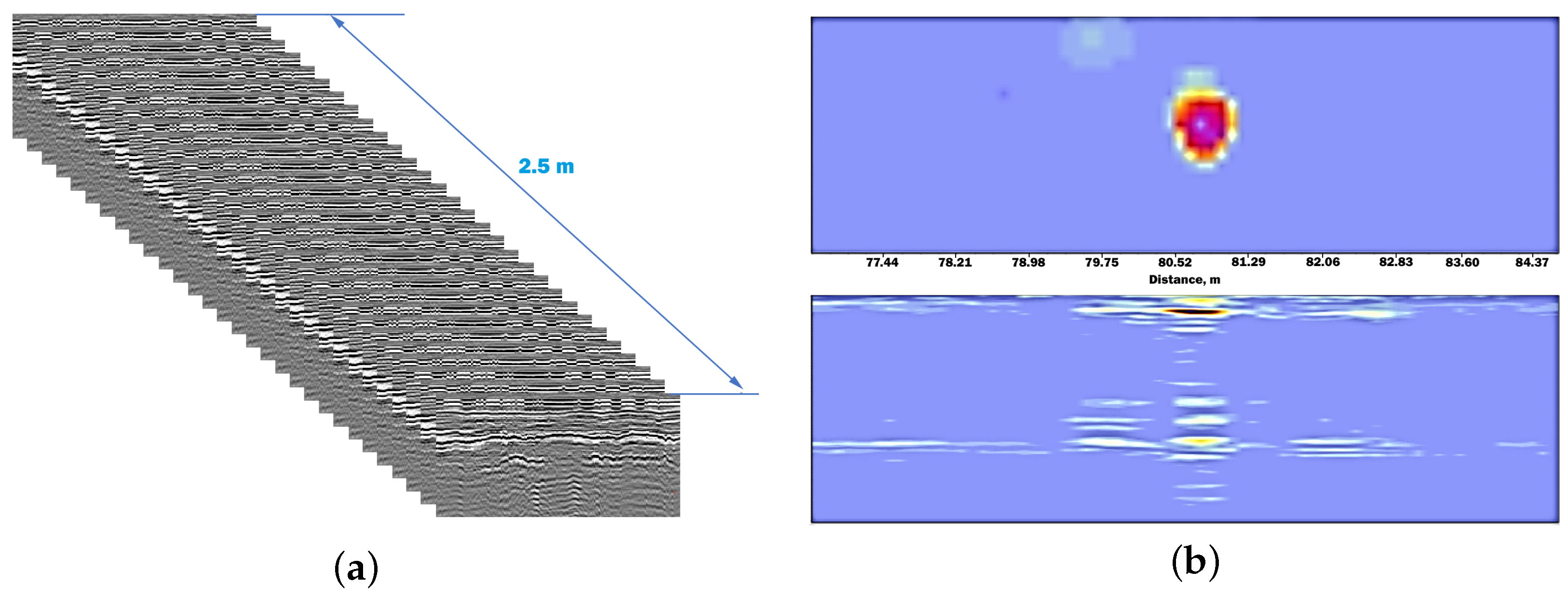

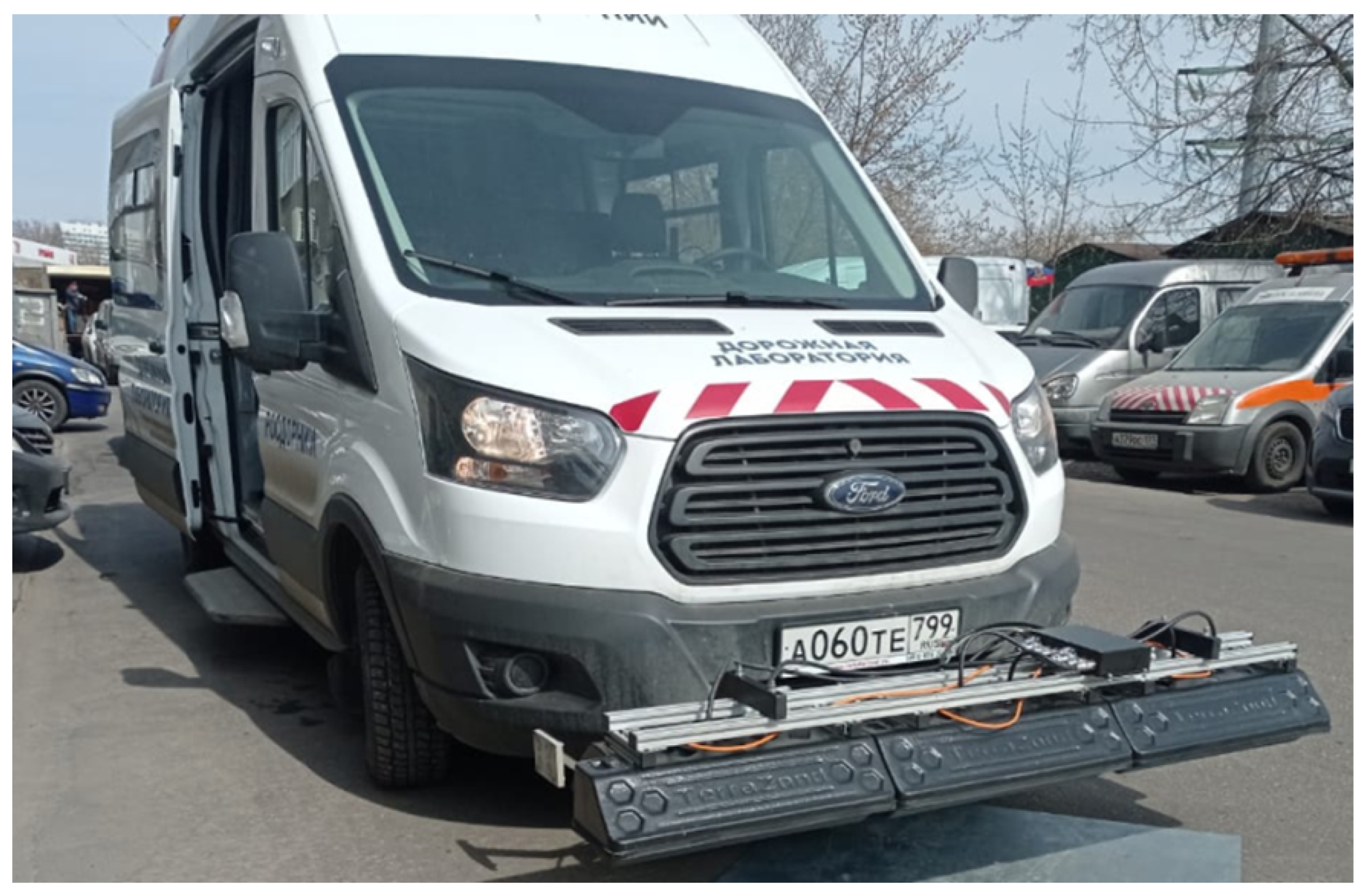
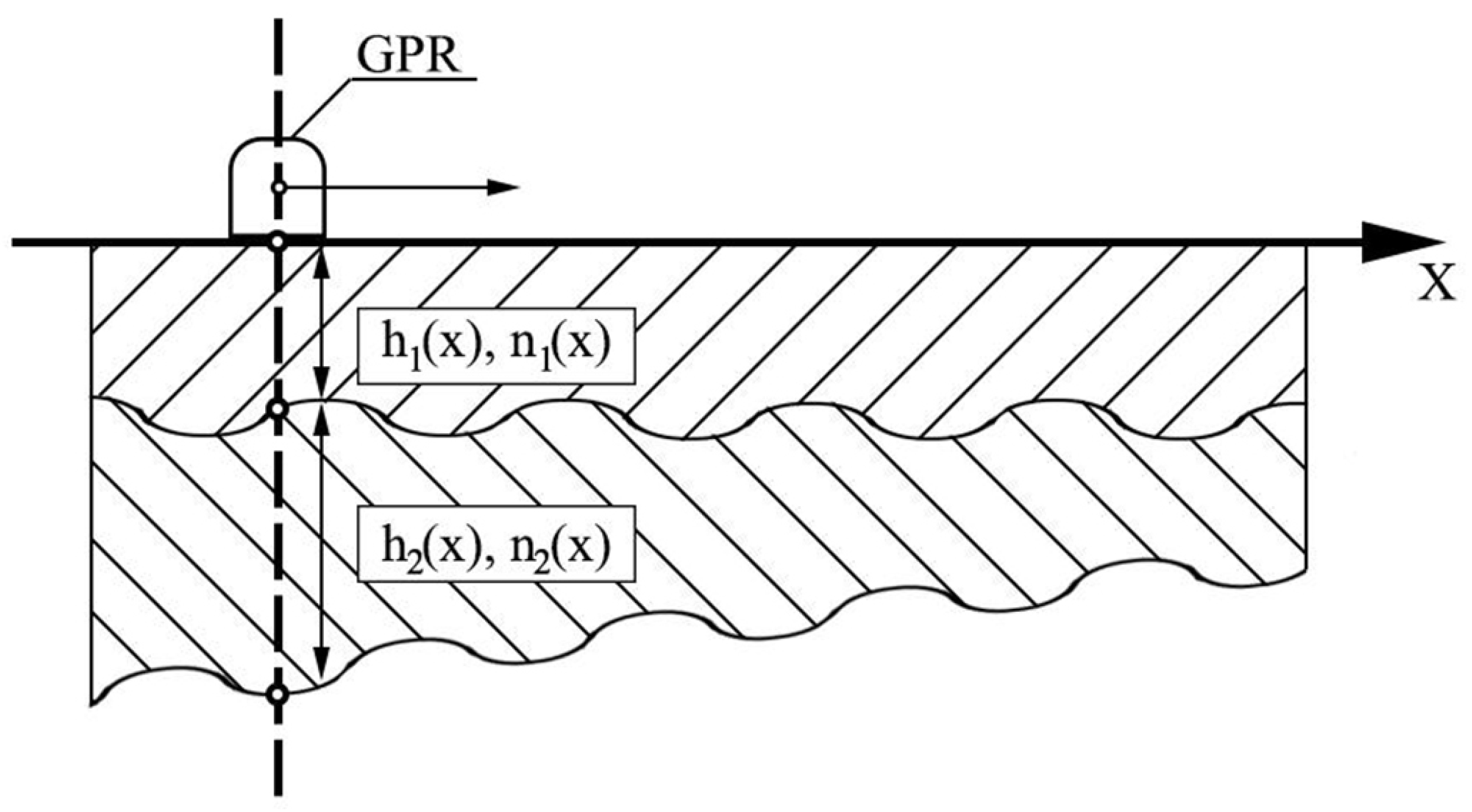


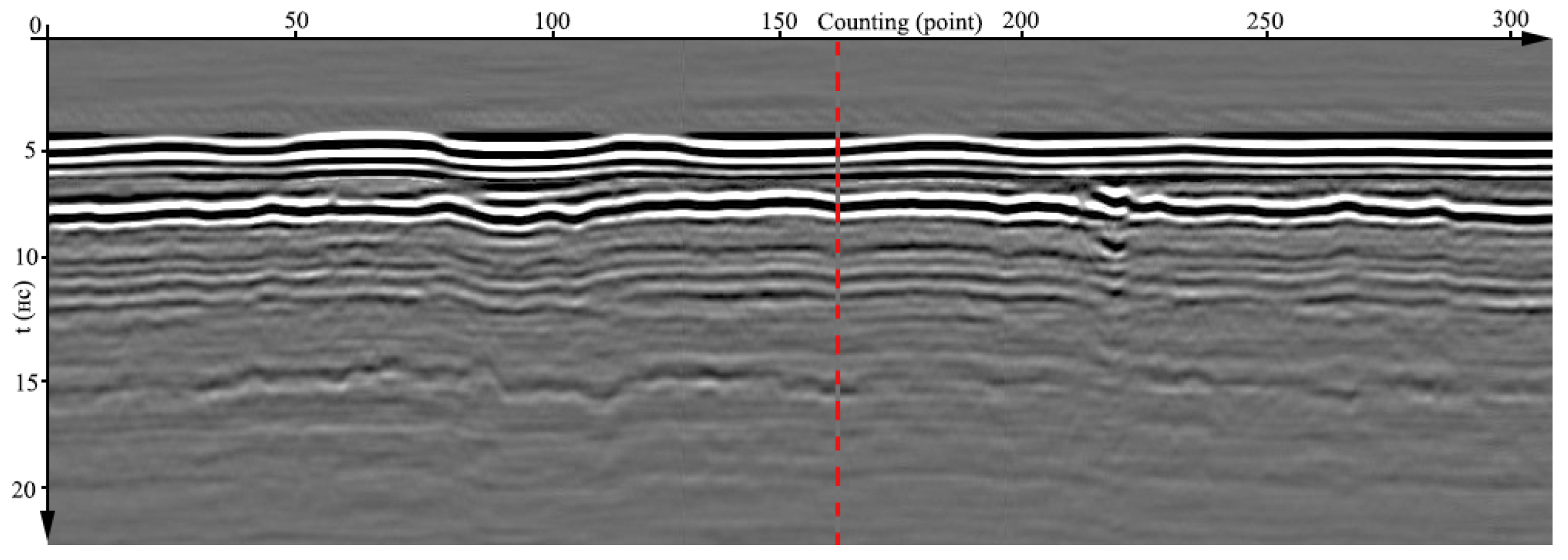
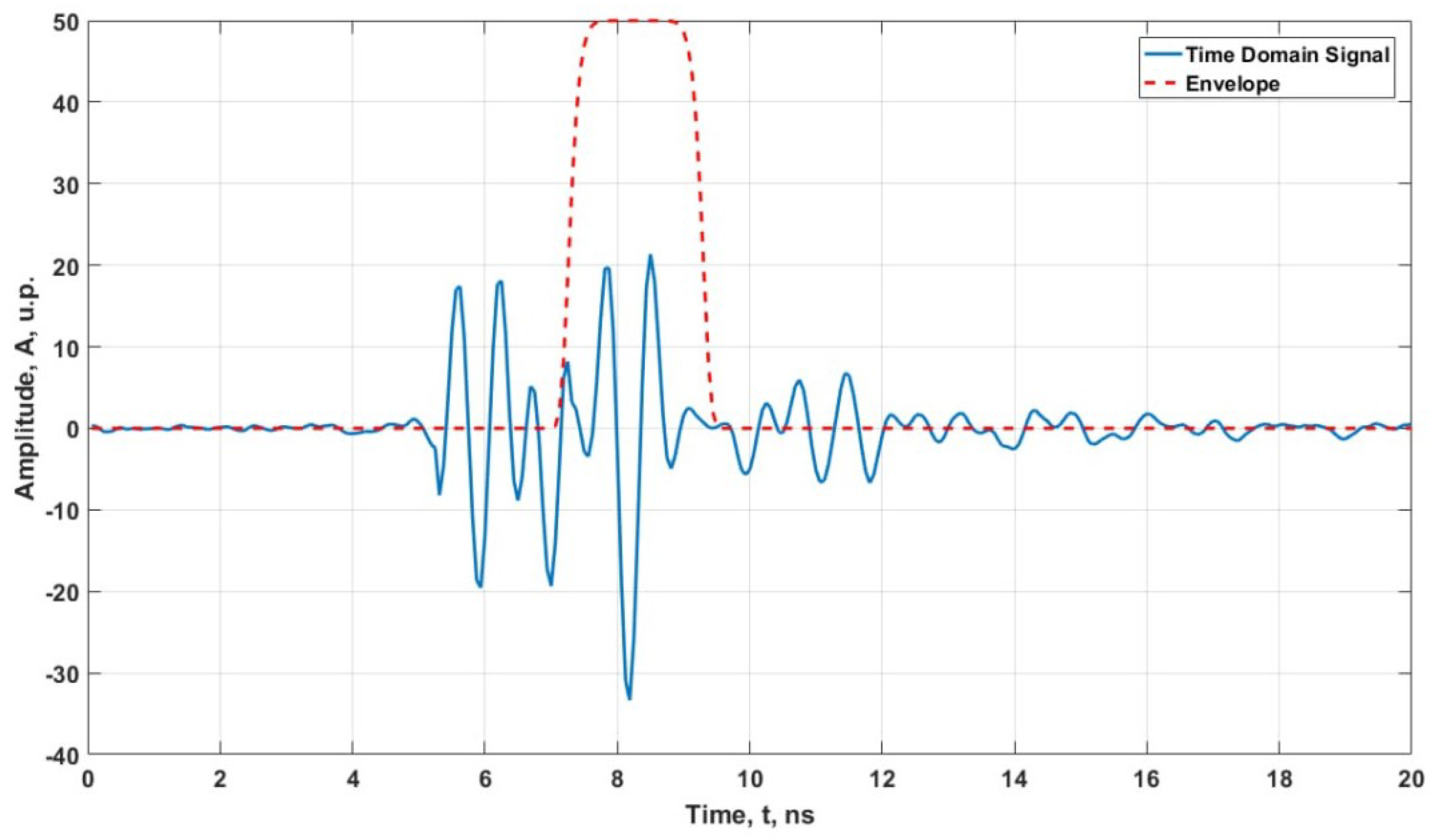
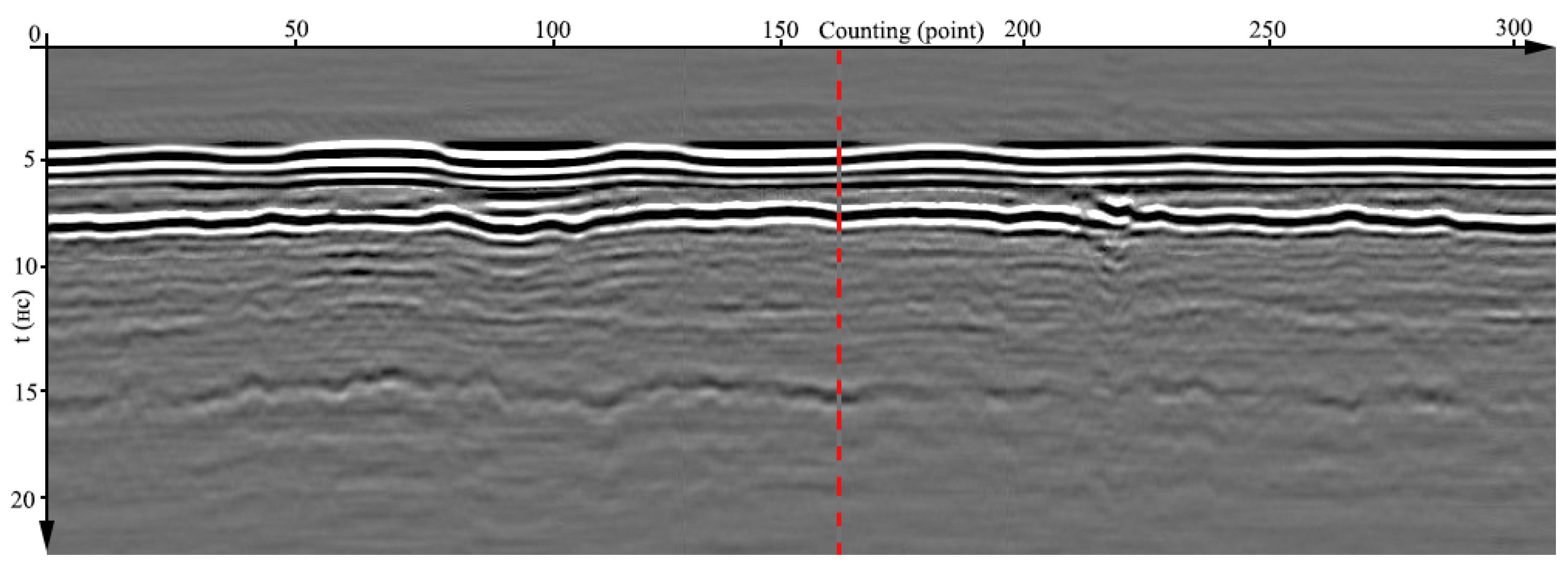
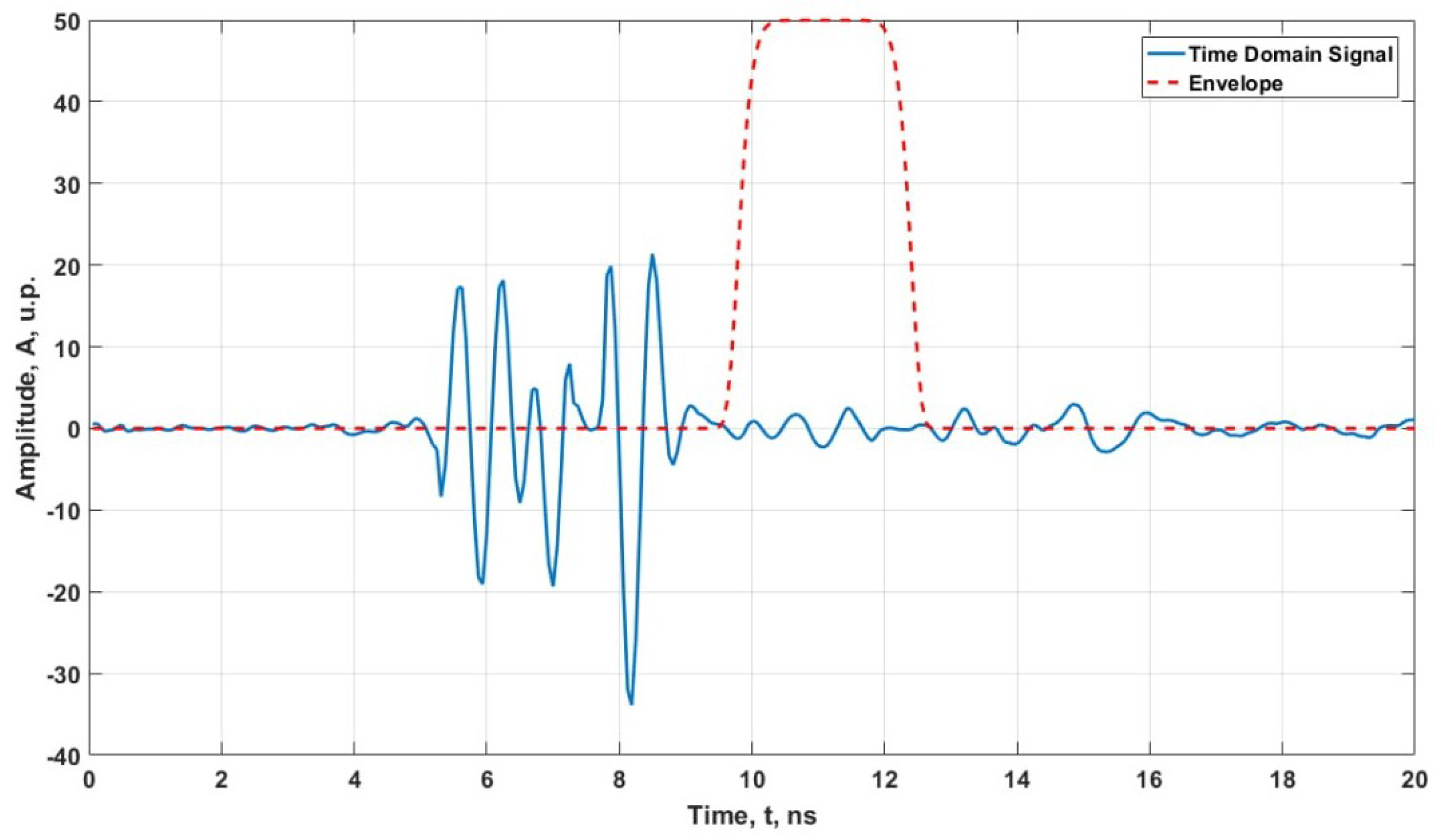
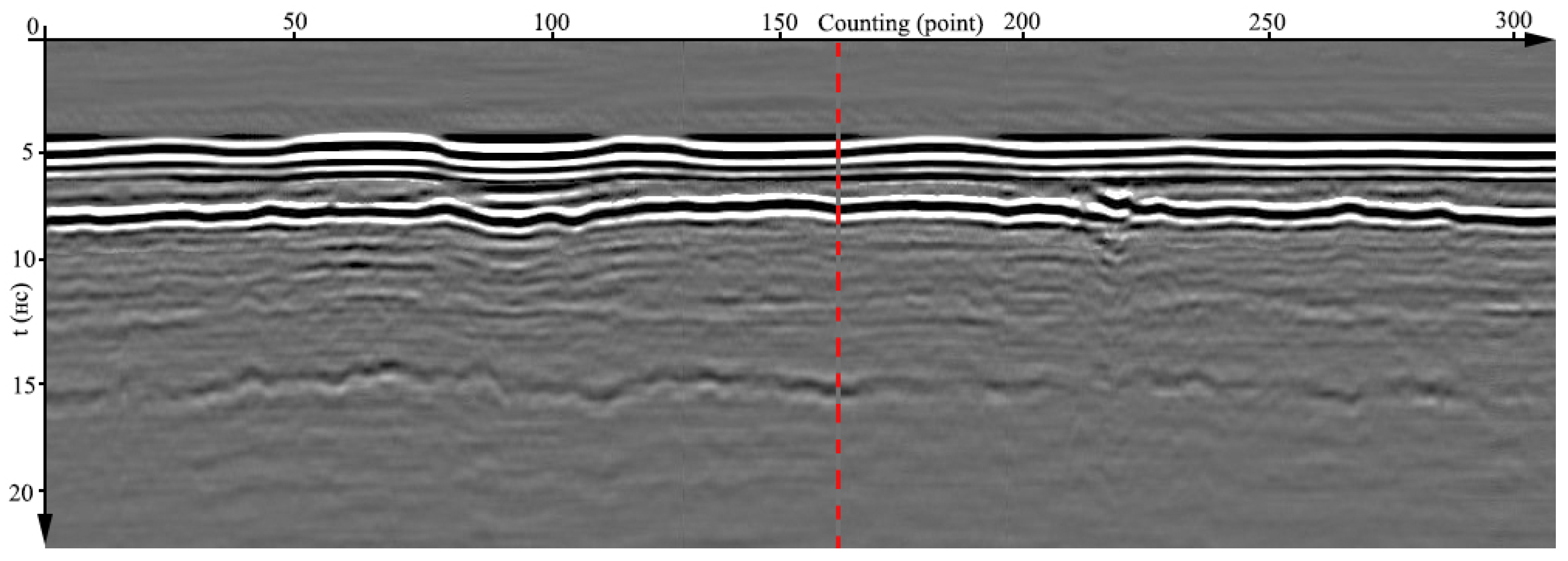
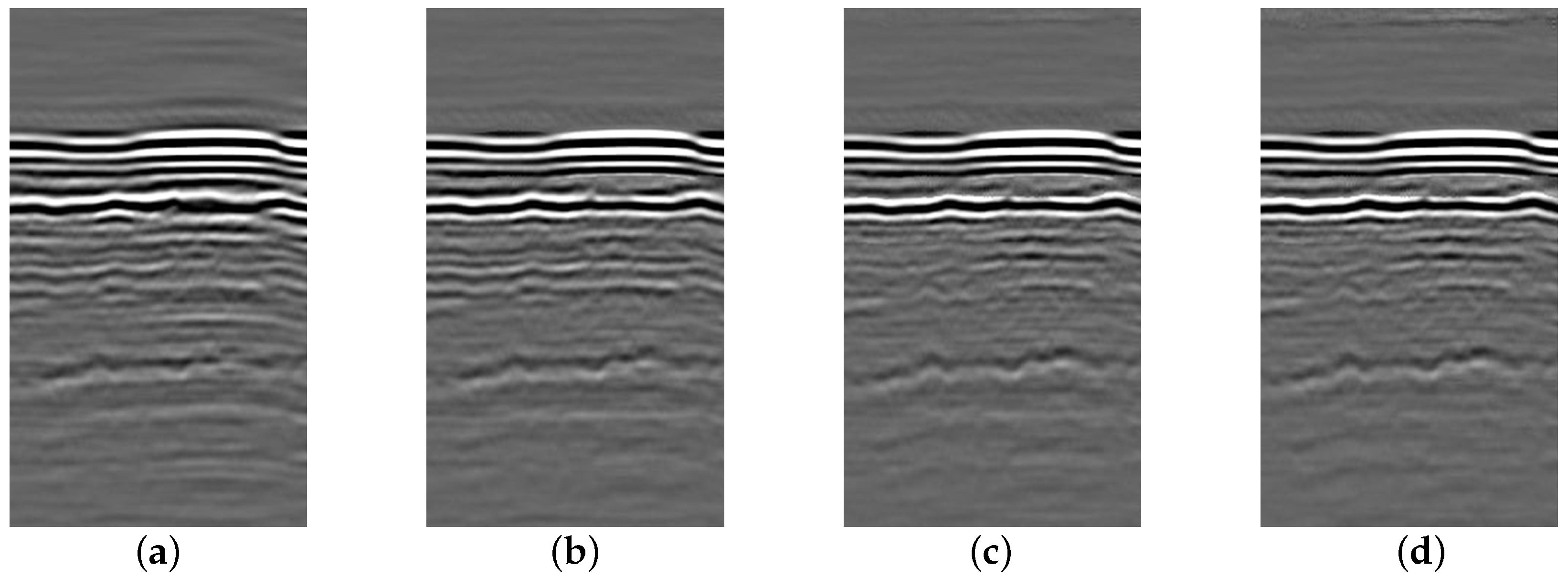
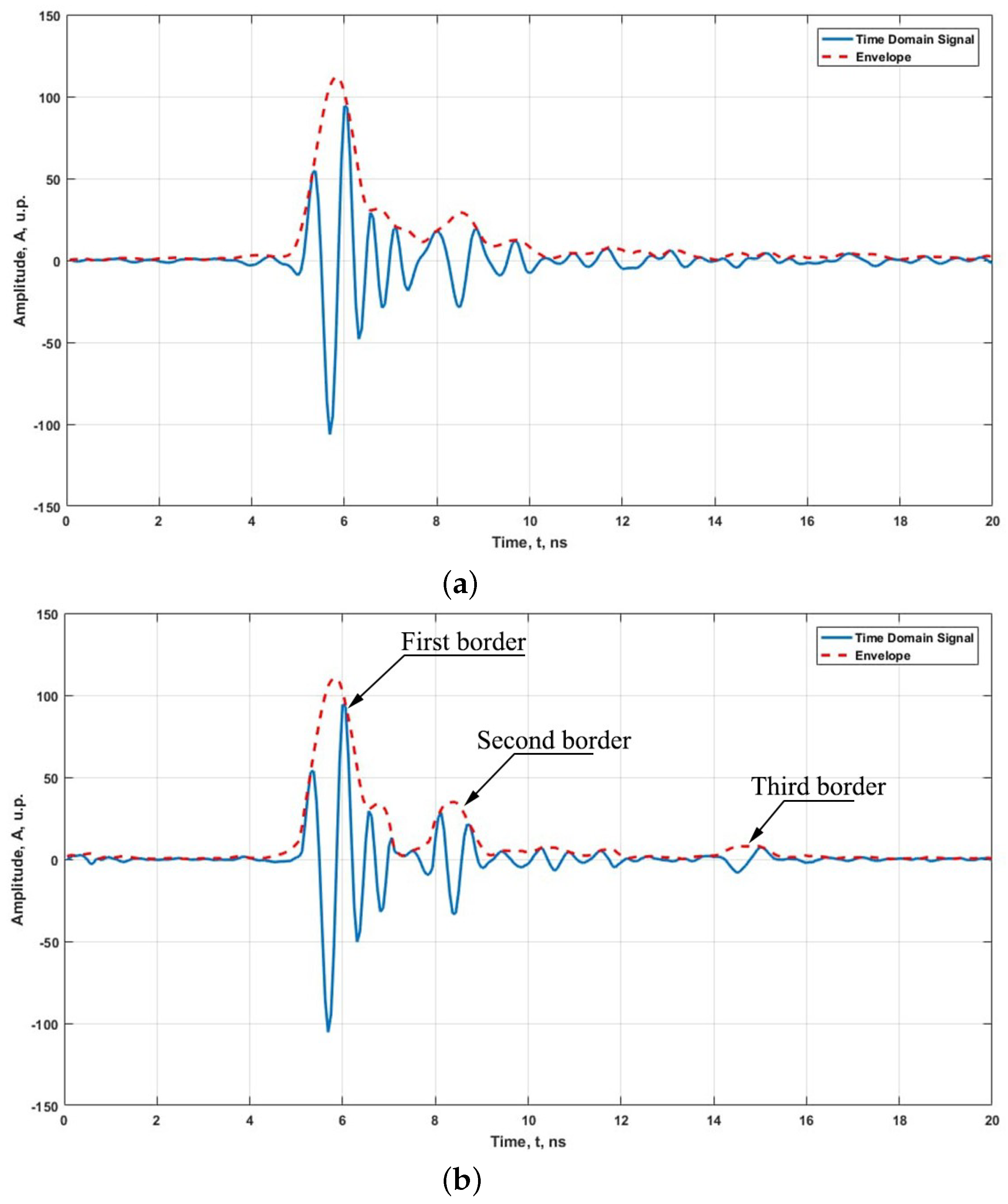
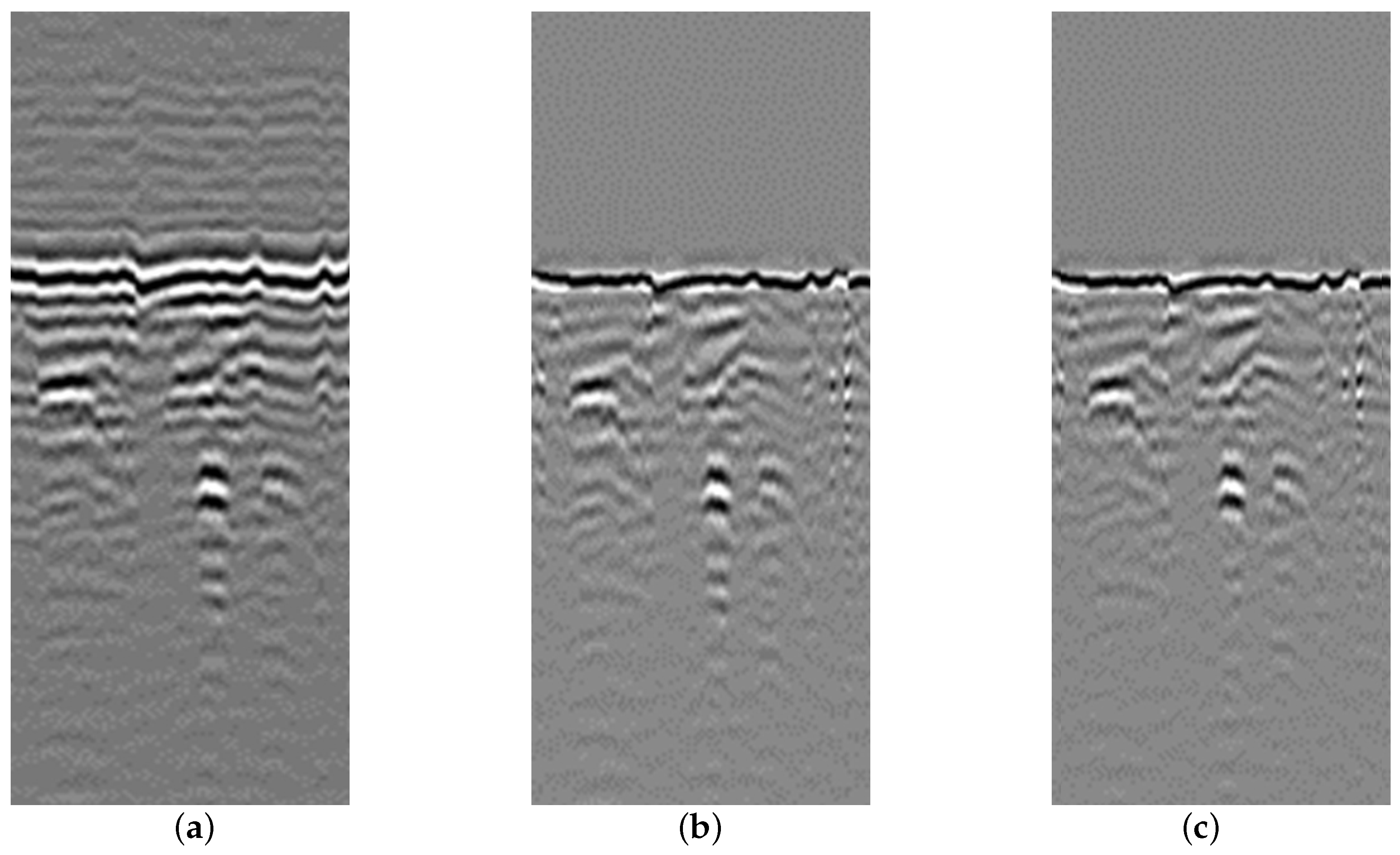
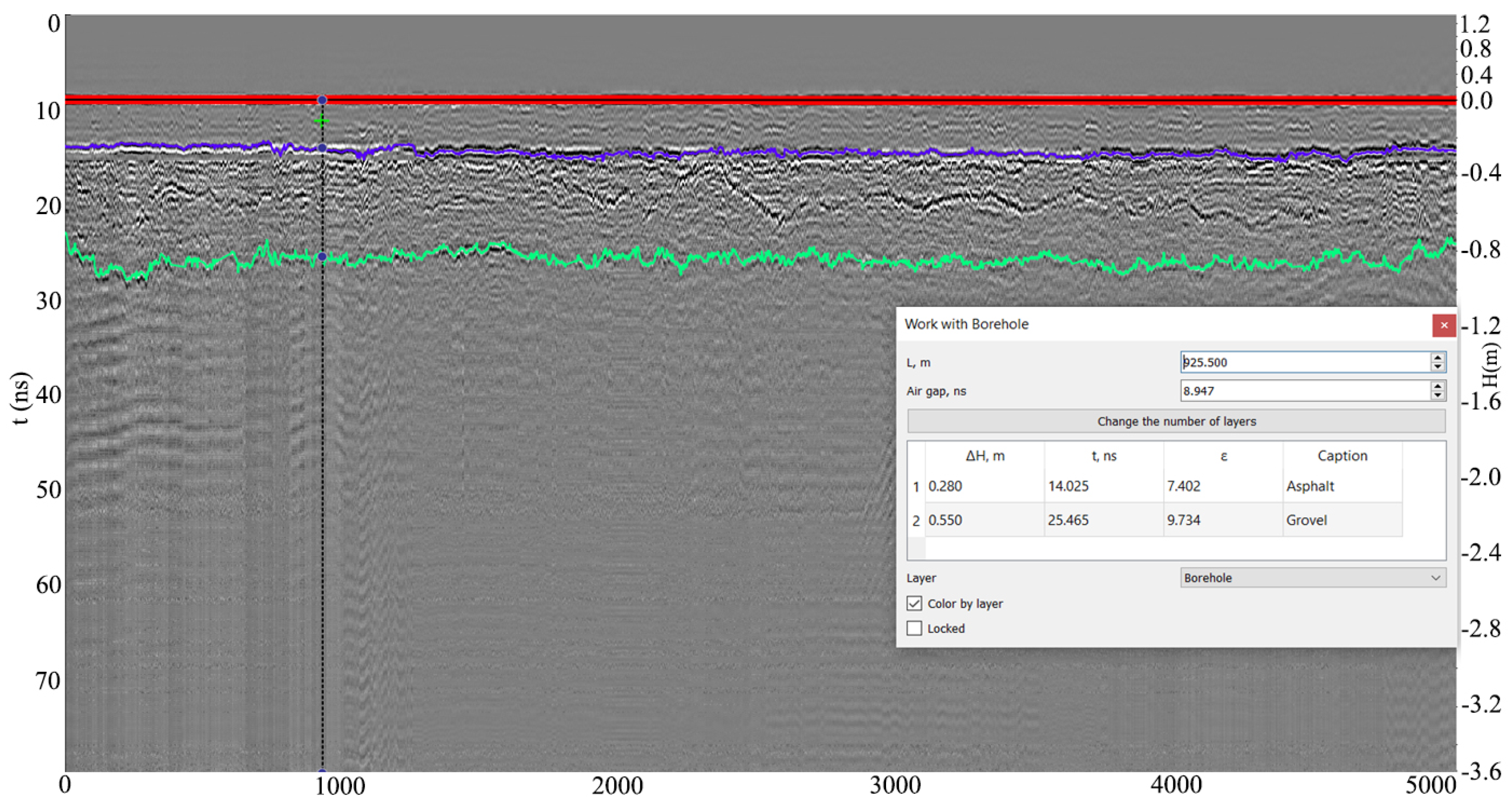
| Measuring Point No. | Point Assignment | Layer Thickness, cm | Discrepancy | ||
|---|---|---|---|---|---|
| Drilling Measurement | Measurement by GPR Series GRT-3 | cm | % | ||
| 1 | Verification | 11.5 | 11.9 | −0.4 | −3.48 |
| 2 | Calibration | 11.0 | 10.5 | 0.5 | 4.55 |
| 3 | Calibration | 11.0 | 11.3 | −0.3 | −2.73 |
| 4 | Calibration | 13.0 | 13.4 | −0.4 | −3.08 |
| 5 | Verification | 11.0 | 11.5 | −0.5 | −4.55 |
Disclaimer/Publisher’s Note: The statements, opinions and data contained in all publications are solely those of the individual author(s) and contributor(s) and not of MDPI and/or the editor(s). MDPI and/or the editor(s) disclaim responsibility for any injury to people or property resulting from any ideas, methods, instructions or products referred to in the content. |
© 2023 by the authors. Licensee MDPI, Basel, Switzerland. This article is an open access article distributed under the terms and conditions of the Creative Commons Attribution (CC BY) license (https://creativecommons.org/licenses/by/4.0/).
Share and Cite
Gorst, A.; Tseplyaev, I.; Eremeev, A.; Satarov, R.; Shipilov, S.; Fedyanin, I.; Khmelev, V.; Romanov, D.; Eremin, R. Common-Mode Clutter Filtering for the Problem of Sounding Multilayer Media Using Ground-Penetrating Radar. Remote Sens. 2023, 15, 2751. https://doi.org/10.3390/rs15112751
Gorst A, Tseplyaev I, Eremeev A, Satarov R, Shipilov S, Fedyanin I, Khmelev V, Romanov D, Eremin R. Common-Mode Clutter Filtering for the Problem of Sounding Multilayer Media Using Ground-Penetrating Radar. Remote Sensing. 2023; 15(11):2751. https://doi.org/10.3390/rs15112751
Chicago/Turabian StyleGorst, Aleksandr, Ilya Tseplyaev, Aleksandr Eremeev, Rail Satarov, Sergey Shipilov, Ivan Fedyanin, Vitaly Khmelev, Dmitry Romanov, and Roman Eremin. 2023. "Common-Mode Clutter Filtering for the Problem of Sounding Multilayer Media Using Ground-Penetrating Radar" Remote Sensing 15, no. 11: 2751. https://doi.org/10.3390/rs15112751
APA StyleGorst, A., Tseplyaev, I., Eremeev, A., Satarov, R., Shipilov, S., Fedyanin, I., Khmelev, V., Romanov, D., & Eremin, R. (2023). Common-Mode Clutter Filtering for the Problem of Sounding Multilayer Media Using Ground-Penetrating Radar. Remote Sensing, 15(11), 2751. https://doi.org/10.3390/rs15112751






